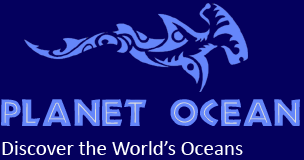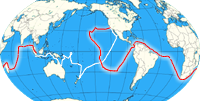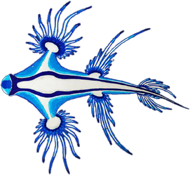The Islas de Revillagigedo have always been one of our dream destinations. This was the main reason we sailed the long way from French Polynesia up to Hawai’i, over to California and down to Mexico. This archipelago lies about 250 nm southwest from the southern tip of the Baja California, has a total area of app. 157 km² and consists of four islands. No people are permanently living there, although there is a naval station in the south of Socorro Island with a population of 45 and a small naval garrison with 9 men on Clarion.
Already in the 1990ies the special flora and fauna of those islands was noticed and the Mexican Government established the islands as a Biosphere Reserve in 1994. The Revillagigedo Island Marine Reserve was established and is an underwater reserve which is monitored by the Mexican Navy since 1999. In 2016 it was also recognized as UNESCO natural heritage site, as well as a completely protected National Park within the Mexican National Parks in 2017. For the safety of the remaining endemic and special flora and fauna on the islands nobody except Navy staff and scientists are allowed on shore.
The Revillagigedos are situated at the junction of the California current from the north and the Equatorrial current. Those two currents generate a very productive and complex zone around the islands. That is the reason why the area is especially rich in marine life and very important as so called “stepping stone” and resting place for a lot of species above and under water. The waters are full of sharks, rays, big pelagic fish, humpback whales, turtles and especially giant oceanic manta rays. Furthermore the visibility with more than 50 meters under water is excellent.
14 of the 16 resident taxa of land birds, one sea bird and all four native terrestrial vertebrates (2 snakes, 2 lizards) are endemic (meaning they only occur here). Socorro, the biggest island, also has a lot of endemic plant taxa. In comparison the small island of Clarion, which is also the farthest away from the mainland, has only a few endemic plants. All four islands are of volcanic origin, but only San Benedicto is still active. The last eruption was 1952 and left not only a spectacular volcanic cone but also eliminated the only endemic bird species on this island.
The islands here are especially known by divers around the world and are also called “Mexican Galapagos”. This is one of the few places on earth where you can always see many Giant Manta Rays. Those Giant Manta Rays interact with divers like on no other place on earth. Depending on the season one can also see different species of sharks, especially Silky, Hammerhead, Galapagos and Tiger Sharks as well as the huge Whale Sharks. In the spring the Humpback Whales give birth in the water around the islands. We heard them singing quite often during our dives and also inside our boat, when we were lying in bed. Also Bottlenose Dolphins are often seen during dives and do not seem to mind the divers.
Every boat wanting to visit this archipelago needs special permission. In the last few years there were some administrative changes and the Revillagigedos are now a part of the Mexican National Parks, where you have to apply. After we received our permit, which was free and needed only a little paperwork, we were full of anticipation when we set sail from Cabo San Lucas. After two and a half days sailing in good wind conditions we arrived at San Benedicto and anchored in the south of the island for a day. There is sandy bottom with good holding and not many rocks – if you find the right spot. After this short stopover we wanted to continue towards Socorro, the biggest island, because some sailing friends of ours were anchored there. We were impressed by the landscape with the huge cinder cone and the cold lava stream from the 1950ies. Although we were tired we made a first dive at the so called “Canyon”, where we saw two Hammerheads circling with a group of fish. Amazing! What a great start to our diving adventure.
In the evening we continued towards Punta Tosca on the northwestern side of Socorro. The anchorage there is quite deep but we were sheltered from the strong northerly winds behind the cliffs. After the anchor was down we saw some Silky Sharks (Carcharhinus falciformis) swimming around our boat. They swam towards our anchor chain and checked out our swimming ladder. It did not look very inviting to go swimming off the boat ;-) Here we did some dives at the “Wall”, a rock wall which juts out into the open ocean. In the shallow area at the place called “Aquarium” we observed some Green Turtles (Chelonia mydas), which also nest on the few sandy beaches of the islands. White-tipped Reefsharks (Triaenodon obesus) and Galapagos Sharks (Carcharhinus galapagensis) could be seen during every dive. The Silky Sharks (Carcharhinus falciformis) were very abundant at the anchorage, which we had realized while anchoring. You need nerves of steel to go snorkeling since the Silky Sharks are very curious and swim very close into your comfort zone, meaning their personal distance is not very much. Finally we saw our first Giant Oceanic Manta Ray (Mobula birostris) “flying by” during one dive. He was not very interested in us and was just gliding along the rock wall. Regularly the humpback whales swam by our boat. Suddenly a calf jumped completely out of the water next to Pakia tea. Followed closely by his mother, who was so close that she splashed water at us. A fantastic show!
After a few windy days we needed to check in at the military station in the south of Socorro. There they checked our permit and filled out some paperwork. Afterwards we sailed to the eastern side and anchored at Cabo Pearce, our next diving spot. This anchorage is generally very open and so we had some swell for a few days.
There were also plenty of Silky Sharks around, which got especially active at night when we suspended a dive torch into the water. Right away they started to hunt in the light. Later also some dolphins joined the hunt and so there was a lot of action around Pakia tea. Just do not fall into the water!
All other sailing boats had left in the meantime and so we were alone, only sometimes joined by one or more of the dive charter vessels. They usually only stay one or two days on any anchorage. Since we did two dives a day we timed them so we were alone in the water and not with one of the big dive groups. Often we were the only boat around anyway.
After a few trials we found a way to safely anchor our dinghy without damaging the corals. For this we took a 20 m of 10 mm anchor chain, which we floated with some buoys. So only the anchor is on the bottom and the heavy anchor chain is floating above the corals. At the end of our dives we floated the anchor and chain with additional floating devices (waterproof bag, diving buoy) and made our safety stop while the dinghy and chain with the anchor were carried along by the current. The main reason we used the chain instead of a rope was that the Giant Manta Rays can see it better. We have read and heard that sometimes if they do not see a rope they get tangled in it and start to make somersaults, since they can not swim backwards. So they get tangled even more and it happened that they would take off with the dinghy in tow. With our set-up we saw right away that the manta rays were able to see and easily avoid our anchor gear. Also, we didn’t have to worry about chafe and could be confident to find our dinghy where we had left it.
Cabo Pearce is a spectacular dive spot. Starting with a steep rock wall, which goes far down, there are ridges going out into the open ocean. Full of expectations we jumped into the water and the first thing we saw was a Manta ray. Afterwards we got visited by three Bottlenose Dolphins (Tursiops truncatus) which came very close and swam around us as if they just wanted to say Hello. At night we were often visited by Humpback Whales which slept right next to our Pakia tea, so we could listen to the conversation between mother and calf very closely. We always checked the water before jumping in but one time I almost hit a Manta, which was swimming around our dinghy or checking it out. Apart from the Mantas we also saw different sharks (White-tipped Reef-, Silky-, Galapagos- and Hammerhead Sharks), Yellowfin Tuna (Thunnus albacares), a Wahoo (Acanthocybium solandri) and much more. Every dive was special and we never knew what to expect.
After a wonderful time in Cabo Pearce we sailed back to San Benedicto to finally dive the world famous “Boiler”. This spot is known to be a cleaning station for Giant Manta Rays (Mobula birostris). It is a huge, vertical rock where the top is only about 2 m under the water surface, which is beautifully grown over by corals. This is also the reason why you should not anchor on the top of this rock. On the eastern side we found a ridge in a depth of 10 m, where we were able to drop our anchor without destroying any corals. This rock is named Boiler because when the swell is high the water on top seems to boil. If you are not a guest on board of one of the big diving vessels, you should wait for good conditions – low swell, little wind. Also the current can be quite strong at times. On our first dive we met a big group of other divers around the Boiler. But we still saw 7 different Giant Manta Rays, which were very interested in us divers and the bubbles we made. We really enjoyed this sight and discovered our first “Black Morph Manta”. Those are completely black on their back and black with a white pattern on their belly. Normally between 25-30% of a manta population are “Black Morphs”, in the Revillagigedo Archipelago this percentage is the highest in the world. Even our own Manta ID pictures are up to 35% Black Morph Manta. The rest of our dives at the Boiler we were alone under water with lots of fantastic and incredible interactions and sightings of manta rays. They really are very curious and came very close at times. We tried to get as many ID pictures as possible, to put them at the disposal of the Pacific Manta Ray Project. We also observed the cleaning of the manta rays. In the Revillagigedos this is done by the Clarion-Angelfish (Holacanthus clarionensis). The manta swims close to the Boiler and makes a slight upward movement with his whole body. This seems to be the invitation for the Clarion-Angelfish to start cleaning. He swims towards the manta and starts to pick external parasites from his skin. They also clean the gills and gill arches. Often we observed a Clarion-Angelfish watching a manta ray swimming by, then waiting for the signal and swimming out towards it to start their work.
Um den Boiler sehen wir manchmal Galapagoshaie (Carcharhinus galapagensis) und große Schulen von Grossaugenmakrelen (Caranx sexfasciatus), sowie Grüne Meeresschildkröten (Chelonia mydas).
Around the Boiler we sometimes saw big Galapagos sharks (Carcharhinus galapagensis) and a big school of Bigeye Trevally (Caranx sexfasciatus), as well as Green Turtles (Chelonia mydas).
At the southern dive spot called “Canyon” we always saw Giant Manta Rays as well, especially at our favorite place called “Manta Rock”. Often they would accompany us during our dives. The manta rays were also very interested in our dinghy-anchor-set-up. They sometimes watched Tom while he would inflate our bag and dive balloon and watched us doing the safety stop. A few days a group of Bottlenose Dolphins (Tursiops truncatus) was visiting this dive spot and swam around us during our dives. If we stayed calm under water some sharks were swimming close by, for example a very curious Silvertip Shark (Carcharhinus albimarginatus). Maybe he was only interested in Tom’s big underwater camera? Silky Sharks (Carcharhinus falciformis) were always there when we came towards the surface. So we could take great pictures and observe their interesting behavior. Usually Silky Sharks live in the open ocean and hunt above the continental shelf. At oceanic islands along the American coast (Revillagigedos, Cocos, Galapagos) you can find them in big groups. This has something to do with their breeding - according to a study the Silky Sharks give birth between May and August in this geographical region. This seems to be true since during our first visit in February and March there were plenty of Silky Sharks everywhere. When we came back in November we did not see a single one.
Very interesting is the amount of spiny lobsters. There are so many that we often saw them walking around in open areas during the day without having a care, and they were sitting in big groups in crevices and caves. Nowhere else have we seen as many spiny lobsters as here, especially none walking around in broad daylight. Normally we find only a few sitting in small holes during the day. Since the archipelago is a no-take zone and therefore fishing and other extractive activities are strictly forbidden, the spiny lobsters can increase their number only limited by natural predation.
After San Benedicto we visited Punta Tosca on Socorro once more, where we finally saw one Tiger Shark (Galeocerdo cuvier). We were diving along the “Wall” when he showed up above us. He was behaving very strangely since he swam towards our bubbles at the surface. He seemed irritated and disappeared soon into the blue of the ocean. The rest of our dive we constantly looked over our shoulder but did not see him again.
In November we even saw a whale shark (Rhincodon typus) at our last dive in Cabo Pearce. We heard about them showing up around the islands in the fall, but did not think we would see one. Lucky for us we did!
Then it was finally time for us to leave this fantastic dive area. All our dives were spectacular and will stay vivid in our memories. How can we plan our sailing route to end up here once more?




.jpg)


.jpg)

.jpg)
_are_swimming_around.jpg)
.jpg)

.jpg)


.jpg)
.jpg)
.jpg)





.jpg)

.jpg)
.jpg)

.jpg)
.jpg)
.jpg)
.jpg)
.jpg)
.jpg)

.jpg)
.jpg)
.jpg)
.jpg)



.jpg)
.jpg)
.jpg)
.jpg)

.jpg)

.jpg)

.jpg)
.jpg)
jpg.jpg)
.jpg)
.jpg)

.jpg)
.jpg)











.jpg)

.jpg)
.jpg)


.jpg)
.jpg)
.jpg)
.jpg)
.jpg)


.jpg)
.jpg)
.jpg)
.jpg)



.jpg)
.jpg)
.jpg)
.jpg)
.jpg)


.jpg)


.jpg)


_like_to_accompany_the_Silky_Sharks.jpg)

.jpg)
.jpg)

.jpg)
.jpg)

 >>planned route - join us ...
>>planned route - join us ...